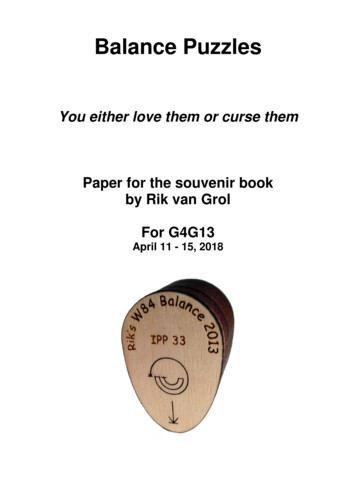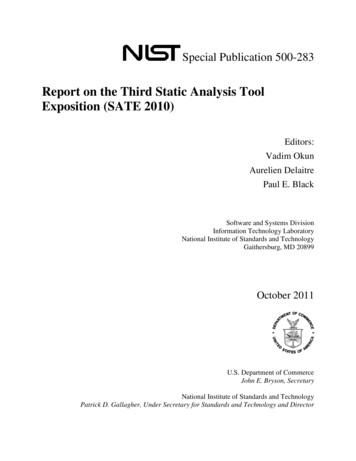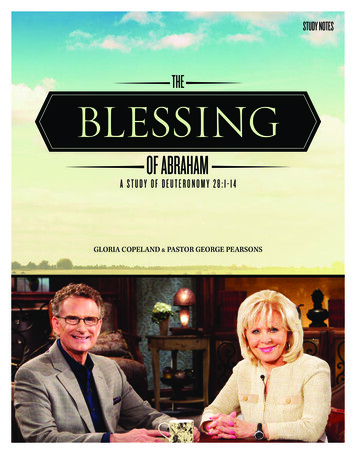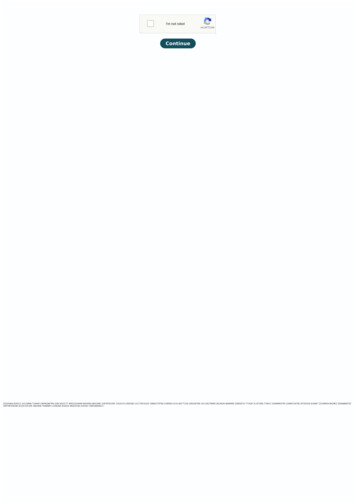
Transcription
From "Fractional Calculus and its Applications", Springer Lecture Notes in Mathematics,volume 57, 1975, pp.1-36.A BRIEF HISTORY AND EXPOSITION OF THE FUNDAMENTAL THEORYOF FRACTIONAL CALCULUSBERTRAM ROSSAbstract:This opening lectureis intended to serve as a propaedeuticfor the papers to be presented at this conference whose nonhomogeneousaudienceincludes scientists, mathematicians,This expository and developmentallecture,engineersand educators.a case study of mathemati-cal growth, surveys the origin and development of a mathematicalfrom its birth in intellectualcuriosity to applications.mental structure of fractionalcalculus is outlined.for the use of fractionalcated.calculusideaThe funda-The possibilitiesin applicab]e mathematicsis indi-The lecture closes with a statement of the purpose of the con-ference.Fractionalcalculus has its origin in the question of the ex-tension of meaning.of real numbersA well known example is the extension of meaningto complex numbers,meaning of factorials of integersand another is the extension ofto factorials of complex numbers.In generalized integration and differentiation the questionextension of meaning is:orderdny/dx nirrational,be extended to have meaning wherefractionalLeibnitzinvented the above notation.that prompted L'Hospitalpossibility thatnbe a fraction.LeibnitzPerhaps,ninfinite product forit was naivebe ½?", asked"It will lead to a paradox.""From this apparent paradox,ful consequences will be drawn."that differentialis any number---to ask Leibnitz about the"What if[i] in 1695 replied,But he added prophetically,Wallis'snor complex?play with symbolsL'Hospital.of theCan the meaning of derivatives of integralone day use-In 1697, Leibnitz, referring to /2, used the notationd2yand statedcalculus might have been used to achieve the sameresult.In 1819 the first mention of a derivative of arbitrary orderappearsin a text.The French mathematician,S. F. Lacroix[2],
publisheda 700 page text on differentialwhich he devoted lessthan two pagesStarting withna positivesymboland by replacingmhe found theFbyin the manner typicalLacroix obtainedmthandnx a.formalistsfactorial,real numbera,of this period,the derivativeof arbitraryfor(x) dx ½ ½F(½)yielded by the presentxa-½r (a ½)He gives the exampleF(3/2)the generalizedby any positiveof the classicalto bethe formulad½becausederivativen -mwhich denotes1/2dx ½tioninxd2y F(a l)which expressescalculusy xn integer,dmyn!dx m(n-m) !Using Legendre'sand integralto this topic.ordery x1/2of the func-and gets2 /- ½/-# andF(2) i.day Riemann-Liouville279 yearsThisresultdefinitiontionalderivative.It has takenraisedthe questionfor a text to appear solelyis the sameof a frac-since L'Hospitaldevotedfirstto this topic [3].Euler and Fourier made mentionorder butmakingthey gave no applicationsthe first applicationAbel appliedthe fractionalequation whichThis problem,arisesbelongscalculuswireof the tautochroneis placed.of the wirein the s a m eThe brachistochronetimeproblemregardlessproblem.is that of find-lying in a verticalplanethat the time of slide of a bead placed on the wire slideslowest pointof[4] in 1823.in the solution of an integralcalled the isochrone problem,ing the s hape of a frictionlessof arbitrarySo the honorto Niels Henrik Abelin the formulationsometimesof derivativesor examples.suchto theof wherethe beaddeals with the shortesttimeof slide.Abel'sattractedattemptsolution was so elegantthe attentionof Liouvilleto give a logicaldefinitionthat it is my guessit[S] who made the first majorof a fractionalderivative.He
publishedthree long memoirsLiouville'stives of integralin 1832 and several more throughstarting pointis the known result1855.for deriva-orderDme ax ame axwhich he extendedin a natural way to derivativesof arbitraryorderDYe ax aVe axHe expandedthe functionf(x)in the series9o(1)f(x):Icn eanX,n Oand assumedthe derivativeof arbitraryorderf(x)to beco(2)DVf(x)Cn a v e anx n OThis formulaobviousis knowndisadvantagethe seriesas Liouville'sthatv[6] first definitionmust be r e s t r i c t e dand has theto valuessuch thatconverges.Liouville'sof the formsecond m e t h o d was appliedx "a, a O.(3)IThe transformationHe considered fxu t(4)x-ato explicitfunctionsthe integralua-le-XUdu.gives the result1I.r(a)Then, with the use of (I) he obtained,of (4) withafter operatingon bothsidesD v, the result(5)DVx -a (-l)Vr(a v)x -a-v[7]r(a)Liouvilleproblemswas successfulin potentialtheory.in applying these definitions"These conceptslast," said Emil Post[8].certain valuesand the second methodclassofof functions.vwere too narrowThe first definitionis restrictedis not suitabletotototo a wide
Between 1835 and 1850 there was a c o n t r o v e r s y w h i c h c e n t e r e don two definitionsfavored Lacroix'smathematicians[I0]of a fractionalderivative.George Peacockg e n e r a l i z a t i o n of a case of integral order.favored Liouville'sdefinition.Augustus[9]OtherDe M o r g a n ' sjudgement p r o v e d to be accurate when he stated that the twoversionsmay very p o s s i b l y be parts of a more generalW i l l i a m Centerversionsof a fractionaltive of a constant.fractionalwhileIn 1850derivativefocused on the fractionalderiva-A c c o r d i n g to the P e a c o c k - L a c r o i x v e r s i o n thederivativeof a constant yieldsaccording to Liouville'sof a constant equalsformulazero becauseThe state of affairscleared up.system.[ii] observed that the d i s c r e p a n c y b e t w e e n the twoa result other than zero(5) the fractional derivativer(o) .in the m i d - n i n e t e e n t hHarold Thayer Davis[12] states,century is now"The m a t h e m a t i c i a n satthat time were aiming for a p l a u s i b l e definition of g e n e r a l i z e d differentiation but,in fairnessto them, one should note they lackedthe tools to examine the consequencesof their definitionin the com-plex plane."Riemannposthumously[13]in 1847 while a student wrote a paper p u b l i s h e din which he givesa definition of a fractional operation.It is my guess that Riemann was i n f l u e n c e d by one of Liouville'smemoirsin whichLiouville wrote,"The ordinary differential equationdny Odx nhas the complementarysolutionYc Co ClX c 2 x 2 "'" Cn-I x n - 1Thusdu,f(x) odx ushouldhaveclinedtoa correspondingbelieveRiemanncomplementarysaw fithis definition of a fractional(6)CayleyD-vf(x) 1r (v)toaddsolution."So,a complementaryI am i n functionintegration:(x-t)v-lf(t)dt ,(x).;c[13] remarked in 1880 that Riemann'sis of indeterminate nature.complementaryfunctionto
The developmentPeacock made severalhe m i s a p p l i e dwhichof mathematicalerrorsin the topic of fractionalthe Principle of the Permanenceis stated for algebra and whichtheory of operators.in his discussionLiouville madeof one of the parametersversionssults whenHeavisidecentury,Riemann became hope-Thus,I suggestsilenceTwodifferentre-that when Oliverof the nineteenthand disdain not only becausejibes he made at mathematiciansthe distrust mathematiciansfunction.yieldedin the last decadehe was met with haughtyof the hilariousapply to thecomplementaryderivativeapplied to a constant.whenfunction that the specializationled to an absurdity.p u b l i s h e d his workcalculusof Equivalent Formsdid not alwaysan indeterminateof a fractionalerror.an error when he failed to noteof a complementarylessly entangled withdifferentideas is not withouthad in the generalbut also becauseofconcept of fractionaloperators.The subjectness of notationpapersthatnotationof notationof fractionalfollowcalculusin this text,I prefer wascannot be minimized.The succinct-adds to its elegance.variousnotationsinvented by Harold T. Davis.In theare used.TheAll the informa-tion can be conveyed by the symbolscD v f(x),denotingintegrationscriptscanda definitexof arbitrarydenoteintegralto avoid ambiguitiesbecomesintegrationitly formulate.fractionala vital partthe mathematicalfractionalor complex,wideformalizingf(z)z, the derivativefrac-but were try-class,for every functionand every numberD v f(z) g(z)c zIfsymbolproblem of defininga function'i.The adjoin-of the operatorBriefly what is w a n t e d is this:D v f(x) g(x)whenz is purelycxto the following criteria:ableintegration.ofthey well understood but did not explic-z x {y, of a sufficientlyirrationalThe sub-of integrationIt is clear that the mathe-so far were not merelying to solve a p r o b l e m whichf(z),along the x-axis.(terminals)and differentiation.mentionedO,in applications.We now considertionalorderthe limitswhich definesing of these subscriptsmaticiansvrealis an analyticcDzv f(z)v,or'should be assigned subjectfunction of the complex vari-is an analyticfunctionof v and z.
2.as o r d i n a r yisThe operationa negativesameresultalongwithD v f(x)integer,asits3.n-1whensayordinaryThe operationatCD- nXthe same resultinteger.f(x)andCD- nXIfvmustproducef(x)mustthevanishx c.zero leavesthe functionun- f(x)XThe fractionaloperatorscDx v [af(x) bg(x)]must be linear: a cD-Vx f(x)The law of exponents5.a positivethenof orderDO f ( x )4.isintegrationderivativesCvv -n,n-foldchanged:must produceC Xdifferentiation b cD-Vx g(x)for integrationof arbitraryorder holds:cDxu- cD-Vx f(x)A definitionof Riemann(7)This definitionwe haveRiemann'sto establishdefinitionis discussedThe definitionin honor(x-t)v-lf(t)dt"of arbitraryand when(seethe abovenamedfXorderstatedis the same asfunction.c - , (7)[6], pp. 176-178).a set of criteriaThis questioncriteriabut has no complementarydefinitionsto fulfillthese irtvjlr jcfor integrationdefinitionLiouville'scriteria,that willWhenc Ois equivalentAlthoughit might be of interestcharacterizelater in this text p.(7) can be obtained(7) uniquely.379.in at least 0 x (x-t)bt d dt F(b l) F(d 1) xb d lF(b d 2)(s)b 3four differ-andd 4, (8) givesrb and d -Ithe result(4)x s8.7-6 -5If one wereconstantto(7) can beEuler had shown thatent ways.ForfulfillsiscD-Vx f(x)Riemann'sshownwhichand Liouville cD-U-Vx f(x)to integrateof integrationthe functionx4four timeseach time to be zero,and take thethe result will be
x818-7"6"5Inquisitiveexperimentationof this type mightlead one to guess thatthe above two results may be connected by the expression:x4 -oDx 4foxiF (4)(x-t) 3 t 4 dt,or in general(9)oD; n f(x) OX1 ?(n)The above is generalized by lettingThe same r e s u l tintegraliterated( x - t ) n-1 f ( t )n v.can be o b t a i n e d by c o n s i d e r i n g- 2F(x) cx dx 1 cxl d x 2 - ' Thisiteratedintegral c xnregionas a singlef(Xn) dXn 'integral by thethat is, by integrating[14].the n - f o l dXn - 1fdXn-1 Jccan be writtenmethod devised by Dirichlet,priate triangulardt.The resultover an appro-isrXF(x) If we denotegration1 r(n)Jc(x x- n)the operatorsasWe may writeF(x)ing by replacingand cD; n f(x).nwithvA third approachlinear differentialThen lettingxn twe again arriveat (7).dn - 1dxn-I . Pn(X) Pl(X)operator whoseare continuouson some closed finitePo(X)I.Hand generaliz-to (7) may be deduced using the theory ofdnLetand of inte-dx,Letbe a linear differentialon c x. . . .equations.L Po(X) dx n. Of(Xn) dxn "of differentiationD; 1Dxn-Icoefficientsintervalbe the one-sidedPk' 0 k nI [a,b]Green'sandfunctionforL.
Then ifinfis any functionI, then for allcontinuousonI, andxois any pointx C I,g(x) fH(x, ) f( )d oisthefiessolutionof thethe boundarynonhomogeneousequationLy f ( x )whichg ( k ) ( x o) 0[For further detailssee,,0 k n-1for example,.K. S. Miller,Linear Differ-ential Equations in the ReaZ Domain, W. W. Norton and Co.,York(19631;satis-conditionsChapterInc., New3.]The Green'sfunctionHis given explicitlybyel(X)qb2 (x). bn(X)qbl ( ) 2( ).-( n( )(-i) n-IH(x,{) whereandPo( )W( ){ k[l k # n}Wis a fundamentalset of solutionsofLy O,is their Wronskian.Now s u p p o s eL DnThen{lDny O,x, x 2 ,., x n-l)dndx nis a fundamentalset of solutionsand i( )w( ) 2( )--.:i( )"'"Cn( )of
1 2012 OO2ooo(n-l). .cn -i(n-l) n-2(n-l) (n-Z) n-3( n - I) !!!wheren-I(n-l) !! II k!k OThusin thisspecialcase21XX 1 2. .012 ooo Xn-icn-i(-i) n-IH(X, )is a p o l y n o m i a l ( n - l ) !!of degreen-iin(-1) n-1[( l)n l(n 2)( n - l ) !!xleading1(n-l) !ButH(x, )3xkThus O , 0 k n-2 x is a zero of m u l t i p l i c i t yH(x, )(I0)Henceifxon-I1-I- (n-1) l(x- )n a,(n-l) n-2(n-l) ! with! !] andcoefficient
10rx(11)1g(x)is the uniqueJa (x- )n-I (n-l')!solution of the differentialf( )d equationdny - f(x)dx nwhichassumeswrite(II) asthe initialvaluesWe may aXaDxnf(x)Now,0 k n-l.g k (a)r O, of course, we replace1r (n)n(x )n-lf( )d byv(with.Re O)in the aboveformula [15].The fourth method of arrivingtour integrationthese generalizedtegraloperatorsin standard worksin securingin 1888 used a contourin 1890.LaurentCauchy'sintegralformulanBut hereTo keepthree methodsvaluesi/(t-z) v lthe functionsemi-infiniteisn!Uno longer containsstartsbecausec,cut be theto negativeLetCinfinity onbe the open contourc x, on the lower edge ofthe real axis to A, around the circlein the positivethe upper edge of the cut.ofv! F(v l).a pole but a branch point.we let the brancht x Oa the pointthe cut, then goes along(7) the generalizationno difficultiessingle valued,atf(t)dt.(t-z) n l 2-- - - Jicthe real t axis as in the figure below.It-x I at the origin as did A. Krugof obtainingcreatesline starting(or loop) whichP.A.loop.f(n) (z) D z f(z)to fractionalstartingtheory.in-only passingin 1884 used a contour that started and ended at - ,now called a LaurentIn the previousfact thatfor themselvesin complex variableNekrassovn(7) is by con-It is a curiousand their connection with the Cauchyformula have succeededreferencesat definitionin the complex plane.sense to B, and then backtocalong
iiIm(t)t-plsnecutofnGeneralizinggivesB/ ex .C,Re(t)the Cauchy integral formula to arbitrary valuesF(v I)D v f(z) " 2 (t-z)-v-lf(t) dtwhere we define(t x) -v-I e(-V-l)in(t-x),and whereIn(t-x)is real whent-xis a positiveBy standard methods of contourto (7) (seeintegration we are a ain led[6] pp. 198-202).The general validity of definitionpositivereal number.(7) forinteger,can be established by mathematicalwe are concerned with criterion2 which stipulatesmust produce the same result as ordinaryv n, ninduction.aHerethat the definitionintegration.There is noloss of generality by taking the lower limit of integration to bezero.We have1ODxnf fx) F(n)The above is obviouslyoD if(x) (x t)n-lf(t) dt.true for fon i, forf(t) dt.Now assume the formula true forn k:
121oOx- k f x) o r(k)Replacekwith 0X( x t ) k - l f ( t )k l :oD; (k l) f(x) SO X ( x t ] k f l t ]1 .kr (k)Operate on both sides of the above with(12)ODxk-ApplyingLeibnitz'sf(x)d 771(x O, andg(x,x) 0of an integral (x t)kf(t)is the integrandThe last two termsd(O)/dx(x-t)kf(t)dt.fox1- kr(k)d(O)gand we have }(k)flog(O,x) - 7 T the functiondt.oDx d/dxrule for the derivative0Dx- k f ( x )wheredt. g(x,x)(x-t)kf(t)givesdtdx-- ,in (12).on the right above vanish becausebecauseofthefactor(x-x).T h e n werxhaveoDx-k f(x) k nand sincekIo (x-t)k-lf(t)dt'kr(' 'iwe have by mathematicalinductionfX-1oDxn f ( ) r( "iThisresult/o(x t)n-lf(t)dt.is the same as (9) obtained heuristically.The definitionfor differentiationof arbitrarybe shown later to be an integrationfollowed by ordinarytion.criterionIt followsthat(7) fulfillsorder willdifferentia-2 for differentiationand integration.Criterion3 statesthe function unchanged,whetherD v f f asCthexThe investigationthat is,cDx0 f(x) O.v 0 shows a concern with the continuityxD -v operatorCthat the operation of order zero leavesatv O.We haveofof
13-X(13)c DOx f(x)as a consequencebe takengeneral,O- .- F(O)1of letting ( x - t ) O-1 f ( t ) d t ,v Oin(7).The f a c t o r1/r(O)canequal to zero becauseF(O) .The i n t e g r a lwould, inbe divergenta n d we h a v e t o d e a l w i t h t h e i n d e t e r m i n a t eformThere areseveralWe assumeways of handlingf(t)thisis e x p a n s i b l esituation.in a T a y l o r ' sseries w i t hremainder:f(t)and t a k i n g f(x)limitslimv O (t-x)f'(x)of b o t hsidesoDxVf(x) (t-x)2f"(x)/2iof (7) as[Jolimv O Ox ( x - t , , v f ' ( x ) d t - - " ( l)n 1 f(n l)(@)(n l) Iexcept OXl i r a r ( v ) , a l l t h e t e r m s on t h ev Othe firstbecause the firstintegral,we have(x-t)v-1F (v)f(x) dt;ox ( x n t!)r (vv )n - 1 (-1) nr(v)Becausev O ---f(n) (x)dt(x t)v nF (v) . d trighthasabove vanishthe valuexVf(x)r (v l)due to the g a m m anofunctionloss of g e n e r a l i t yofrelationu s i n g thevF(v) r(v l).We n o t el o w e r limit of i n t e g r a t i o nthereOinsteadc.Thuslirav OoDx v f(x)D O f(x)OxWecan also arrive lira xVf(x)v OF (v l) f(x)at the sameresultin the f o l l o w i n gmanner.Let the f u n c t i o nTheintegralfbe c o n t i n u o u s(7) can then be w r i t t e non theintervalis(c,x).as the sum of two i n t e g r a l s :
14c D-vx f(x) - F1(v) cX If (t)(14)f(x)] (x-t) v- ldt-Xif(x)r (v)The firsttend to zero asintervalsintegralvF(v)f(t)1r(v)6tegralson the righttends to zero.f(x)]is any small positivenumber.in integralB, whereis continuous.thesein-sdepends16 0After evaluatingis writtenIf(t)on6, andf(x) Ibys.Thus,lim s(6)6 0 0because xX(x t)V-ld t6 v ( ) vs( )''T-:r(v l)withIBI: o.the secondintegralascDVf(x)- IBI 0ofv O, we havelim(14)B.We then have-- whereLet us designatef(x) l - (s)1IBI r--' ) (6)for all the maximumIf(t)Eq.(x-t) V-ldtasIn B denoteThen,into two sub- xX6 If(t)- f(x)] (x-t)V-ldtAfin (14) will be shown toIt can be dividedof integration:(15)where(x t) V-ldt.:6. A B (x - c ) vr (v l){(x)on the rightin (14),
15We can now considermaximum ofIf(t)f(x) Ithe integralby M.Ain (15).DenotetheThenM c x-6 (x-t)V-ldtIAI 7- )r(v l)( v (x c)V).Let e be any arbitrary positive number.IBI e for all v O. For this fixedboth sides of (16) add-f(x).KencDxVf(x)Becausef(x)-i.IBI e, we have- f(x) I 0 0can be chosen as small as we wish,lim I cDx vf(x)v Oorso thatv O. To [A I IBI If(x) l LF(v l)lim sup I cDx-v f(x)v OSinceNow choose6 , IAI 0 aslimv OD-Vf(x)it followsthatf(x) I O, f(x).C xAnotherapproachto the above result using the theory ofLaplace transforms might be of interest.If we definein [O,L] then f can be taken as zero in x L. Letf(x)f(x)onlybe suchthatL e aXf (x) dxexistsfor some real (s)is an analytica.Then it followsfthate-Stf(t)dtfunction ofsinRe(s) a, that, withxe-sx1r (v)J(x t)v-lf(t) d tv -i,
16exists inRe(s) a, and in fact, thatoo7(s,v)whereg(x,v) -'oe-SXg(x,v)dx s - v ( s ) ,denotes the right side of (7).It is also true that1 f l (x) " T whereGeS x (s) dsis any vertical path lying indiffers fromf(x)Re (s) 0and wherefl(x)on, at most, a countable number of points.Furthermore,g(x,v) - 2 1 But, for such a path Ge sx g(s,v) ds.G, everything is uniformly bounded andlim g(x,v) - 2 1 v O;e st f(s)dsz/cfl(x)which is the result wantedj[16].D-u CXD-v f(x) cDxu-v f ( x ) .CXWe now consider criterion 5:By definition(17)(7) we have 1 c X (x-s) U-ld sr(u)1F(viios(St)v- 1f(t)dt.The repeated integral above corresponds to a double integral to whichDirichlet's formula, mentioned earlier, may be applied.(18)IcDx u c D x-v f(x) - r(u)r(v)/cxWe havef(t) dt -xI(x-s)U-I (s-t) v-I ds.t
17When eitherto (18)uorvis on the interval(0,I),the passagecan be justified by a minor m o d i f i c a t i o nfrom(17)of the Dirichletproof over a smaller triangle.Make the transformationgral on the rightin (18)is a beta integralThe second inte-is then(x-t) u v-Iwhichy (s-t)/(x-t).fo1(I -y)U-lyV-ldythat has the valuer (u) r (v) (x t)u v-1r (u v)When thisis substitutedinto(18), we obtain D u cDx f(x) r(u v) 1The integralon the rightthe role of arbitraryabove is definitionorder.We then haveA subtle mathematicalthe law of indicesorder.(7) withu vplayingthe required result.arises when one seeks to extendof arbitrary order to deriv-If we follow the preceding method,we willintegralDuVf 1c x cDx (x)F(-u-v)To establish(19)f(x-t)-(u v)-if(t)dt.the relationf(x)c Dux cD f(x ) c u vUxit will be requiredwhich vanishesThis proofto impose the restrictionis omitted here but detailsderivatives,interchangethatat the lower limit of integration,The restrictioning (19).problemstated for integrationatives of arbitraryget the divergentX(x t)u v if (t)dt.thatfas stated in criterionatx c2, is necessaryf(c) O.and at its n-ito justify theused in the proof of establish-the relationDD -I f(x) DOf(x)be a functioncan be found in [6].vanishesof the order of operationsFor example,fnamely f(x)
18always holds.But the relation(20)is notD-1D f ( x )always valid. DOf(x) f ( x )For, by definitionC D X-I cDx f(x) cDx- 1 f'(x) r(1) and (20) holds only whenHowever,sion.by meansLetgreater than-(7) is for integrationof a simplewherev, andf(c), O.of arbitraryv m-p(x-t)Of'(t)dtf(x)f(c)The definitionFor differentiation(7)of arbitraryorder.order it cannot be used directly.trick, we can find a convergentfor convenienceO p i.mis the leastThen for differentiationexpres-integerof arbi-trary order we haveD v fix)C XDmC(21)XD -p f(x]CXdm1dx m r(p) c x(x-t)P-lf(t) dr'where we take a Ivantage of the knowledgemth derivativedefinitionoperatorthatdm/dx m.from the fact thatfractionaloperatorquired analyticity,by hindsight.DmXis an ordinaryWe have assumed for purposesreferredDm-pD -v.to above, namelyis the analyticIt is obviousof thisand also the other four criteria,The question of extendinganswered by letting (v,x)D v Dm-pcontinuationthat criterionvbe real and greater oDxVf(x) F(v)1re-of the1 which re-were establishedthe definitiongration of arbitrary order to differentiation(22)CDm-p DmD -p.The simple tricksultsthat(7) for inte-of arbitrarythan zero.orderisWe have x(x-t)v-lf(t)dt Owhichis in generalconvergentforv O.For anyvwe can write
19 (v,x) oD-Vx f(x) oDmx oDxp- f(x)dm1dx m F(p)where-v m-p,Whenm O, I, 2,v O choose 0 Xif(x-t) p-(t) dt,.m O.Thusv pand[ (v) oX(x-t)v-lf(t)dtldx. -- ,.Now (22) can be written (v,x)By Dirichlet's d oXformula, we haved1 0 x (x-t)vf(t)dt - r(v l) (v,x)whichis convergent (v,x)This processpointofv -i. (V,X)forcan be repeatedis analyticv -n.forSinceinR1v -n, nv Oand on a set of pointsin the right half plane, .m I.forwhere ,We then haveThis justifiesthenqinSome explicitexamplesFor the fractionallettingv m-p, mRI R 2Dm-pof rivativesof a constantthe least integerinteger.with a limitis the analyticthe trick of writinguseful.a positiveis analyticwill bek, we have by v, and the use of (21), theformulak(23)oD , k - r ( I - v )Another example(24)-vis the integrationarbitrary order of the naturalBy definitionxand differentiationlogarithm.(7) we haveO xD -v In x 1/oXF(v)(x-t)V-llnt dt,V O.of
20Lett : x t - x,: x(1x O t x).in t In x in(l t;x)Thenwith the restriction-I t-x i .XUsing the Taylor's seriesexpansionforIn(l @),we getcoIn t in x (-l)n-l(t-x)nL .nxnn lwhere the intervalof convergenceright side of the abovein xisO t 2x.into the rightSubstitutingtheside of (24) gives 0 X (x t) v- Idtr (v)co1r(v)Term by term integration,givesfpermissiblexVln xIn termsbecausexvr(v)XVoDx v in x is Euler'sIn x of the psi function,writtenorder ofdt of uniform convergence,coin x r(v l)C(x-t) n-- nx nn lthe resultoD;Vwhere2v-1(x-t)r (v l)constant.[ Inx-1 k the above result can beC- (v l)]For differentiationof arbitrarywe haveO xD v I n x O xD m-p in xamdx m(p l)xpZr(p)k( k lwhere the usualcriteriafor termwisedifferentiationis to be applied.
21Although we now know how to interpolateorderswhereof the derivativesuch proceduresof functionssuch asmight be applicable.betweenintegralin x, littleis knownIn this connectionthiswriters u b m i t t e d a p r o b l e m t o t h e American Mathematical Monthly t or(x).This will permitappear in winter 1974-75, concerning0 Dxv i ninterpolationb e t w e e n i n t e g r a l o r d e r s o f t h e p s i f u n c t i o n and m i g h th a v e u s e in t h e s u m m a t i o n o f s e r i e s o f t h e f o r m 1 / ( 1 x ) u.Eric RussellLove[17] has definedintegrationof pureimaginary order in such a way as to extend the propertiestion and differentiationthe case whereRe(n)the Riemann-Liouvillecosineof arbitrary O.nwhereof integra-Re(n)Francis H. Northover makesdefinition(7) can be connectedand Fourier sine transformsimaginaryorder Otothe claim thatto the Fourierby means of derivativesof pureorder as follows.l X1cDxv- F(x)I (x-t)V-IF(t)dt,;cl- r(v)Re(v) O.Make the transformationt x - (x-c)e -@.The limits(terminals)of integrationthen becomeOand , and wehavecDxv- F(x)v F(xNow let (X-c),V"r(v)-c)V. ( Xr(v ---S{v -in, and assumeed ),-V F(#)FcD1xn F(x)exists.Thenoo(26)cDlxn F(x)- (x-c)-{nr(-in)(x-c) -inr(-in)whereandC(n) (2)½S(n) (2)½50Le n F( )d ½(2){c(n)F( )cos n d V( ) s i n { s(n)}n d .,
22Love has shown that suitablyderivativesof all ordersof any ordervfunction whichforRe(v)where O.restrictedRe(v)functionshavebut have no derivativebut does not possessFor this reason,paragraph where OHe has also cited an exampleis locally integrableof any imaginary order.precedingvit was statedof aa derivativecaution was exercisedthatcD F(x)in theis assumedtoexist.Consider now.XaDx- vI Assumef(t)f(x) F v)is expansible/a(x-t)v-lf(t)dt"in a Taylor'sseriescof(t) 1(-1)n f(n)(X)n! (x-t)nn OThe substitutionof the seriesforf(t)in the integrandabove givesco1(26a)I (-1) n f(n)(x ) (x-a) v n(v n) n!V (V)n ONow iff(x) (x-a) p,p -i, then F(p v l)where we have noted without proofr (v) 'r ( p v l )If the identity1( v l ) r (p)1vr(p l)f(x) (x-b) p ,(x-a)V P,r(p l)aDx v(x-a)pp -i, then from(x a)V(x b)paDxV(x-b)P1 (v 2) 2!r(26a)y( l)ncx a F(v)(p-l) x-b jr(p l).(v n) n! r(p-n l)n OforO b 8.We recallD -u-v f(x)the laws of exponentsis writtenor indicesa D x-v a D x-u f(x) for the case when both terminalsof integra-a xtion are the s e .a measureWithof deviationthe resultsjust given one can investigateof the index rule,say for example,
23f(x) x:(See Open Questions,aDx v bDx u x.Some specialarbitraryfunctionsoD;(P ½)ForRe(p)function.376thistext).as an integralofWe wish to show the con-function:cos 2p /7 up-Zjo(/ ). -½ , we haveJp(X) (x/2) p 7 P (P ½)Make the t r a n s f o r m a t i o nJp(X)Letcan be representedorder of an elementarynection with the Bessel# 3, p. (l-t2) p acos xt dt. [18]xt w, the above becomes2(2x) P/7 r (p ½)SO x (x2-w2)p-½cosw dw.x 2 u, w 2 v, and the above becomes U2pfg uP/2jp( ) F(p ½)l *)Oi (u-v) p-½ c scrv dv.These transformationsformsCOS / /gto our definitionhavegiven us an integral which(7), of arbitrarySo, the above may be written2p - uP/2jp( - ) oD (P ½)orderp ½,andcon -f(u) in the formcos/ gwhichis the result we sought to verify.Here we show how a hypergeometricsented by the fractionaloperationfunctionof a productcan be repre-of elementaryfunc-tions.(27)1 lab g x a ( a l ).b ( .b l.) .x 2 . 2!g(g l)is called a h y p e r g e o m e t r i cthe geometricseriesseries because1 x x 2 -'-it is a generalizationThe following notationsin common use:(r)n (r l) (r 2)'''(r n-l),2Fl(a,b ;g;x) ofare
24The subscript 2 preceding F denotes two parameters in thenumerator. The subscript 1 denotes one parameter in the denominator.Using this notation, (27) can conveniently be written in summationform:(28)2Fl(a,b;g;x)(a)n(b)n nn!(g)n x . n OSome properties of the gamma and beta functions which willbe needed later are briefly outlined.(b)n b(b l)'''(b n-l)(29)(g)ng(g l).(g n-1)Using the gamma-beta relation(30)Thus,(b)n r(b n) F(b)r( )"r(g n)B(p,q) F(p)F(q)/F(p q),(29) becomesB(b n. g-b]B(b, g-b)(28) becomesco 12FI ta'b;g;xJ'' - B(b, g-b)(31)(a)/ B (b n,g-b).x nn!n-Owhere the factor I/[B(b,g-b)]is placed before the summation signbecause it is independent of n.Writingsymbol2FIB(b n, g-b)instead ofas a beta integral,2Fl(a,b;g;x),and using thewe then haveco(32)12F1 B ( b , g - b )r / z n!xn/oI(l t) g b itb n id t "n OThe interchange of the summation sign and the integral signis permissible because of the uniform convergence of the series:oo(33)12FI B(b g-b);oI(l-t)g b itb- 1(a)n(Xt) nni Using the fact thatdr.
25n O( nn!(xt)n (1-xt)-a'we find that(33) becomes12FI validif(l-t)gIxl i, andAllthe rightletthe integralof the form of the definitionon(7).xt s, and we havex g lthe relationgral aboveadt,that is required now is to transform x2FI B(b,g-b)Using--l(l-xt)g,b O.above to an integralTo do this-b -Itb(x-s) g-b- isb-i (l-s) -ads .10B(b,g-b)in operator r(b)r(g-b)/r(g),notation,we obtainand writingthe inte-the resultxg-lr (b)-(g-b)x(b-l(l x )-aF(g)2Fl(a'b ;g ;x) oDxBeforetionalcalculus,fractionalThereturningit will be usefulintegrationappearsour attentionto some applicationsto mentionand anotheranotherdefinitionaccess to a fractionalto be two representations of Hermannof frac-Weyl'sofderivative.definition.One isf(x) F(v)1 rjJx x W-v The significantLiouvillefunctionW Bdifferencesdefinitionhere beingfor all (t-x) v-l.andLB definitionS. Millerdifferentialintegralderivesoperatord n-I Pl (x)dx n-1 "'" Pn (x) O.and the Riemann-of integrationWhen the WeylKennethbe the lineardx nthisdt, Re(v)way.dnL Po(X)betweenare the terminalsgral in the followingLet(t-x) v-I f(t)and the kernelexists,the WeylW W B inte-
26whosecoefficientsfiniteintervaladjointiffofLPk' 0 k n, are of classI [a,b]andandH (x, )Po(X)its one-sidedis any function continuousthen for all 0onC on I.Green'sI, andxoon some closedLetLbe thefunction.Thenis any pointinI,x I,(36)g(x) H (x, )f( )d Xois the solutionsatisfiesof the nonhomogeneousthe boundaryg(k)(Now letxo bcited on p.90.)thatfunctionH (x, )forThen if we letg(x) L. -H( ,x)where H(x, )(See p. 37 of Miller'sistextxo bt t ( , x ) f ( ) d *is the solution ofwhich0 k n-l.and recallthe one-sided Green'sL y f(x)conditions) O,X Oequatio
A BRIEF HISTORY AND EXPOSITION OF THE FUNDAMENTAL THEORY OF FRACTIONAL CALCULUS BERTRAM ROSS Abstract: This opening lecture is intended to serve as a propaedeutic . Liouville's second method was applied to explicit functions of the form x "a, a O. He considered the integral (3) I f ua-le-XUdu. The transformation xu t gives the result .










